Salinity and Marine Mammal Dynamics in Barataria Basin: Historic Patterns and Modeled Diversion Scenarios
Abstract
:1. Introduction
2. Materials and Methods
2.1. Historic Salinity Data
2.2. Dolphin Location Data
2.3. Description of Models
2.3.1. ICM Overview and Boundary Conditions
2.3.2. Scenarios Analyzed with the ICM
- Only the Davis Pond fresh water diversion is activated and is operated on the salinity-based control rules defined in its operational control plan [40].
- Both the Davis Pond fresh water diversion and the Mid-Barataria sediment diversion were activated. The Davis Pond diversion used the same operational control as above, and the Mid-Barataria diversion utilized an operational regime optimized to maximize the sediment-to-water ratio in diverted flows (e.g., get the most sediment with the least amount of water).
- The final scenario tested under historic sea level rise rates was a simulation where neither Mid-Barataria sediment diversion nor Davis Pond fresh water diversion was activated.
2.3.3. Delft3D Overview and Boundary Conditions
3. Results
3.1. Historic Trends—Observational Data Analysis
3.2. Model Runs—Scenario Outputs
3.2.1. ICM Results—Hindcast Period
3.2.2. ICM Results—Impact of Diversions under Various Future Conditions and Operational Regimes
3.2.3. Delft3D Results
4. Discussion
4.1. Historic Trends
4.2. ICM Discussion
4.3. Delft3D Discussion
5. Conclusions
Supplementary Materials
Author Contributions
Funding
Acknowledgments
Conflicts of Interest
References
- Inoue, M.; Park, D.; Justic, D.; Wiseman, W.J., Jr. A high-resolution integrated hydrology–hydrodynamic model of the Barataria Basin system. Environ. Model. Softw. 2008, 23, 1122–1132. [Google Scholar] [CrossRef]
- Das, A.; Justic, D.; Inoue, M.; Hoda, A.; Huang, H.; Park, D. Impacts of Mississippi River diversions on salinity gradients in a deltaic Louisiana estuary: Ecological and management implications. Estuar. Coast. Shelf Sci. 2012, 111, 17–26. [Google Scholar] [CrossRef]
- Hornsby, F.; McDonald, T.; Balmer, B.; Speakman, T.; Mullin, K.; Rosel, P.; Wells, R.; Telander, A.; Marcy, P.; Schwacke, L. Using salinity to identify common bottlenose dolphin habitat in Barataria Bay, Louisiana, USA. Endanger. Species Res. 2017, 33, 181–192. [Google Scholar] [CrossRef] [Green Version]
- Habib, E.; Nuttle, W.K.; Rivera-Monroy, V.H.; Gautam, S.; Wang, J.; Meselhe, E.; Twilley, R.R. Assessing Effects of Data Limitations on Salinity Forecasting in Barataria Basin, Louisiana, with a Bayesian Analysis. J. Coast. Res. 2007, 23, 749–763. [Google Scholar] [CrossRef]
- Gagliano, S.M.; Meyer-Arendt, K.J.; Wicker, K.M. Land loss in the Mississippi River deltaic plain. Trans. Gulf Coast Assoc. Geol. Soc. 1981, 31, 295–300. [Google Scholar]
- Wiseman, W.J., Jr.; Swenson, E.; Power, J. Salinity trends in Louisiana estuaries. Estuaries 1990, 13, 265–271. [Google Scholar] [CrossRef]
- McMillan, H.; Krueger, T.; Freer, J. Benchmarking observational uncertainties for hydrology: Rainfall, river discharge and water quality. Hydrol. Process. 2012, 26, 4078–4111. [Google Scholar] [CrossRef]
- Hijuelos, A.C.; Sable, S.E.; O’Connell, A.M.; Geaghan, J.P.; Lindquist, D.C.; White, E.D. Application of species distribution models to identify estuarine hot spots for juvenile nekton. Estuaries Coasts 2016, 1–12. [Google Scholar] [CrossRef]
- Rose, K.A.; Huang, H.; Justic, D.; de Mutsert, K. Simulating fish movement responses to and potential salinity stress from large-scale river diversions. Mar. Coast. Fish. 2014, 6, 43–61. [Google Scholar] [CrossRef]
- Visser, J.; Duke-Sylvester, S. LaVegMod v2: Modeling coastal vegetation dynamics in response to proposed coastal restoration and protection projects in Louisiana, USA. Sustainability 2017, 9, 1625. [Google Scholar] [CrossRef]
- Wells, R.; Schwacke, L.; Rowles, T.; Balmer, B.; Zolman, E.; Speakman, T.; Townsend, F.; Tumlin, M.; Barleycorn, A.; Wilkinson, K. Ranging patterns of common bottlenose dolphins Tursiops truncatus in Barataria Bay, Louisiana, following the Deepwater Horizon oil spill. Endanger. Species Res. 2017, 33, 159–180. [Google Scholar] [CrossRef] [Green Version]
- McDonald, T.; Hornsby, F.; Speakman, T.; Zolman, E.; Mullin, K.; Sinclair, C.; Rosel, P.; Thomas, L.; Schwacke, L. Survival, density, and abundance of common bottlenose dolphins in Barataria Bay (USA) following the Deepwater Horizon oil spill. Endanger. Species Res. 2017, 33, 193–209. [Google Scholar] [CrossRef] [Green Version]
- Miller, C.E. Abundance Trends and Environmental Habitat Usage Patterns of Bottlenose Dolphins (Tursiops truncatus) in Lower Barataria and Caminada Bays, Louisiana. Ph.D. Thesis, Louisiana State University, Baton Rouge, LA, USA, 2003. [Google Scholar]
- Miller, C.E.; Baltz, D.M. Environmental characterization of seasonal trends and foraging habitat of bottlenose dolphins (Tursiops truncatus) in northern Gulf of Mexico bays. Fish. Bull. 2009, 108, 79–86. [Google Scholar]
- National Marine Fisheries Service. A Review of Common Bottlenose Dolphins (Tursiops truncatus truncatus) in the Northern Gulf of Mexico: Population Biology, Potential Threats, and Management; Northern Gulf of Mexico Bay, Sound and Estuary Stocks; National Marine Fisheries Service: Silver Spring, MD, USA, 2011.
- De Mutsert, K.; Cowan, J.H.; Walters, C.J. Using ecopath with ecosim to explore nekton community response to freshwater diversion into a Louisiana estuary. Mar. Coast. Fish. 2012, 4, 104–116. [Google Scholar] [CrossRef]
- De Mutsert, K.; Cowan, J.H. A before-after–control-impact analysis of the effects of a Mississippi River freshwater diversion on estuarine nekton in Louisiana, USA. Estuaries Coasts 2012, 35, 1237–1248. [Google Scholar] [CrossRef]
- Meselhe, E.; McCorquodale, J.A.; Shelden, J.; Dortch, M.; Brown, T.S.; Elkan, P.; Rodrigue, M.D.; Schindler, J.K.; Wang, Z. Ecohydrology component of Louisiana’s 2012 Coastal Master Plan: Mass-balance compartment model. J. Coast. Res. 2013, 67, 16–28. [Google Scholar] [CrossRef]
- Wang, H.; Chen, Q.; Hu, K.; La Peyre, M.K. A modeling study of the impacts of Mississippi river diversion and sea-level rise on water quality of a deltaic estuary. Estuaries Coasts 2016. [Google Scholar] [CrossRef]
- Day, J.W., Jr.; Cable, J.E.; Cowan, J.H.; DeLaune, R.; de Mutsert, K.; Fry, B.; Mashriqui, H.; Justić, D.; Kemp, P.; Lane, R.R.; et al. The impacts of pulsed reintroduction of river water on a Mississippi delta coastal basin. J. Coast. Res. 2009, 54, 225–243. [Google Scholar] [CrossRef]
- Day, J.W., Jr.; Lane, R.; Moerschbaecher, M.; DeLaune, R.; Mendelssohn, I.; Baustian, J.; Twilley, R. Vegetation and soil dynamics of a Louisiana estuary receiving pulsed Mississippi river water following Hurricane Katrina. Estuaries Coasts 2013, 36, 665–682. [Google Scholar] [CrossRef]
- Piazza, B.P.; La Peyre, M.K. Restoration of the annual flood pulse in Breton Sound, Louisiana, USA: Habitat change and nekton community response. Aquat. Biol. 2007, 1, 109–119. [Google Scholar] [CrossRef]
- Piazza, B.P.; La Peyre, M.K. Nekton community response to a large-scale Mississippi River discharge: Examining spatial and temporal response to river management. Estuar. Coast. Shelf Sci. 2011, 91, 379–387. [Google Scholar] [CrossRef]
- Snedden, G.A.; Cretini, K.; Patton, B. Inundation and salinity impacts to above- and belowground productivity in Spartina patens and Spartina alterniflora in the Mississippi River deltaic plain: Implications for using river diversions as restoration tools. Ecol. Eng. 2015, 81, 133–139. [Google Scholar] [CrossRef]
- Flemer, D.A.; Champ, M.A. What is the future fate of estuaries given nutrient over-enrichment, freshwater diversion and low flows? Mar. Pollut. Bull. 2006, 52, 247–258. [Google Scholar] [CrossRef] [PubMed]
- Ward, G.H. Marsh Enhancement by Freshwater Diversion. J. Water Resour. Plan. Mgnag. 1985, 111. [Google Scholar] [CrossRef]
- Sanders, B.F.; Piasecki, M. Mitigation of Salinity Intrusion in Well-mixed Estuaries by Optimization of Freshwater Diversion Rates. J. Hydraul. Eng. 2002, 128. [Google Scholar] [CrossRef]
- Van Beek, J.L.; Roberts, D.; Davis, D.; Sabins, D.; Gagliano, S.M. Recommendations for Freshwater Diversion to Louisiana Estuaries East of the Mississippi River; Coastal Management Section, Louisiana Department of Natural Resurces: Baton Rouge, LA, USA, 1982. Available online: https://repository.library.noaa.gov/view/noaa/2484 (accessed on 25 July 2018).
- Turner, R.E. Water Quality Data from the Barataria Basin, 1994–2016. Gulf of Mexico Research Initiative—Coastal Waters Consortium II: Corpus Christi, TX, USA, 2017. [Google Scholar] [CrossRef]
- White, E.D.; Meselhe, E.; McCorquodale, A.; Couvillion, B.; Dong, Z.; Duke-Sylvester, S.M.; Wang, Y. 2017 Coastal Master Plan: Attachment C3-22: Integrated Compartment Model (ICM) Development; Coastal Protection and Restoration Authority: Baton Rouge, LA, USA, 2017; pp. 1–49.
- Meselhe, E.; White, E.D.; Reed, D.J. 2017 Coastal Master Plan: Appendix C: Modeling Chapter 2—Future Scenarios; Coastal Protection and Restoration Authority: Baton Rouge, LA, USA, 2017; pp. 1–32.
- Couvillion, B.R.; Steyer, G.D.; Wang, H.; Beck, H.J.; Rybczyk, J.M. Forecasting the effects of coastal protection and restoration projects on wetland morphology in coastal Louisiana under multiple environmental uncertainty scenarios. J. Coast. Res. 2013, 67, 29–50. [Google Scholar] [CrossRef]
- Couvillion, B.R.; Beck, H. Marsh collapse thresholds for coastal Louisiana estimated using elevation and vegetation index data. J. Coast. Res. 2013, 63, 58–67. [Google Scholar] [CrossRef]
- Brown, S.; Couvillion, B.; de Mutsert, K.; Fischbach, J.; Roberts, H.; Rodrigue, M.; Schindler, J.; Thomson, G.; Visser, J.; White, E. 2017 Coastal Master Plan: Appendix C: Modeling Chapter 3—Modeling Components and Overview; Version Final; Coastal Protection and Restoration Authority: Baton Rouge, LA, USA, 2017; p. 72.
- Brown, S.; Couvillion, B.; Dong, Z.; Meselhe, E.; Visser, J.; Wang, Y.; White, E. 2017 Coastal Master Plan: Attachment C3-23: ICM Calibration, Validation, and Performance Assessment; Coastal Protection and Restoration Authority: Baton Rouge, LA, USA, 2017; pp. 1–95.
- Meselhe, E.; White, E.; Wang, Y. 2017 Coastal Master Plan: Attachment C3-24: Integrated Compartment Model Uncertainity Analysis; Coastal Protection and Restoration Authority: Baton Rouge, LA, USA, 2017; p. 68.
- Brown, S. 2017 Coastal Master Plan Modeling: Attachment C3-26: Hydrology and Water Quality Boundary Conditions; Coastal Protection and Restoration Authority: Baton Rouge, LA, USA, 2017; pp. 1–44.
- Couvillion, B. 2017 Coastal Master Plan: Attachment C3-27: Landscape Data; Coastal Protection and Restoration Authority: Baton Rouge, LA, USA, 2017; pp. 1–84.
- Sweet, W.V.; Kopp, R.E.; Weaver, C.P.; Obeysekera, J.; Horton, R.M.; Thieler, E.R.; Zervas, C. Global and Regional Sea Level Rise Scenarios for the United States; U.S. Department of Commerce, National Oceanic and Atmospheric Administration, National Ocean Service—Center for Operational Oceanographic Produces and Services: Silver Spring, MD, USA, 2017.
- Coastal Protection and Restoration Authority (CPRA). Davis Pond Operational Plan 2016–2017; Coastal Protection and Restoration Authority (CPRA): Baton Rouge, LA, USA, 2017.
- Reed, D.; Yuill, B. 2017 Coastal Master Plan: Attachment C2-2: Integrated Compartment Model (ICM) Development; Coastal Protection and Restoration Authority: Baton Rouge, LA, USA, 2017; pp. 1–15.
- Coastal Protection and Restoration Authority (CPRA). Louisiana’s Comprehensive Master Plan for a Sustainable Coast: Committed to Our Coast; Coastal Protection and Restoration Authority (CPRA): Baton Rouge, LA, USA, 2017; 392p.
- Liang, M.; Sadid, K.; Xing, F.; Messina, F.; Meselhe, E. TO15/16 Improvement of Model Grid and Bathymetry; The Water Institute of the Gulf. Funded by the Coastal Protection and Restoration Authority under Task Orders 15/16; Coastal Protection and Restoration Authority (CPRA): Baton Rouge, LA, USA, 2016.
- Meselhe, E.; Baustian, M.; Allison, M. Basin Wide Model Development for the Louisiana Coastal Area Mississippi River Hydrodynamic and Delta Management Study; The Water Institute of the Gulf. Prepared for and funded by the Coastal Protection and Restoration Authority; Coastal Protection and Restoration Authority (CPRA): Baton Rouge, LA, USA, 2015.
- Meselhe, E.A.; Jung, H.; Sadid, K.; Messina, F.; Baustian, M.M. TO46: Calibration and Validation of Delft3D Model Version 2—Comparison of V1 and V2 Model Performance; The Water Institute of the Gulf. Funded by the Coastal Protection and Restoration Authority under Task Order 46; Coastal Protection and Restoration Authority (CPRA): Baton Rouge, LA, USA, 2017.
- Messina, F.; Meselhe, E. TO15/16: Improvements to the Hydrodynamics and Salinity in Barataria; The Water Institute of the Gulf. Funded by the Coastal Protection and Restoration Authority under Task Orders 15/16; Coastal Protection and Restoration Authority (CPRA): Baton Rouge, LA, USA, 2016.
- Deltares. Delft3D-FLOW User Manual; Deltares: Delft, The Netherlands, 2014; Available online: http://oss.deltares.nl/web/delft3d/manuals (accessed on 25 July 2018).
- Swenson, E.M.; Cable, J.E.; Fry, B.; Justic, D.; Das, A.; Snedden, G.; Swarzenski, C. Estuarine flushing times influenced by freshwater diversions. Coast. Hydrol. Process. 2006, 33, 403–412. [Google Scholar]
- Alymov, V.; Cobell, Z.; de Mutsert, K.; Dong, Z.; Duke-Sylvester, S.; Fischbach, J.; Hanegan, K.; Lewis, K.; Lindquist, D.; McCorquodale, J.A.; et al. 2017 Coastal Master Plan: Appendix C: Modeling Chapter 4—Model Outcomes and Interpretations; Coastal Protection and Restoration Authority: Baton Rouge, LA, USA, 2017; 418p.
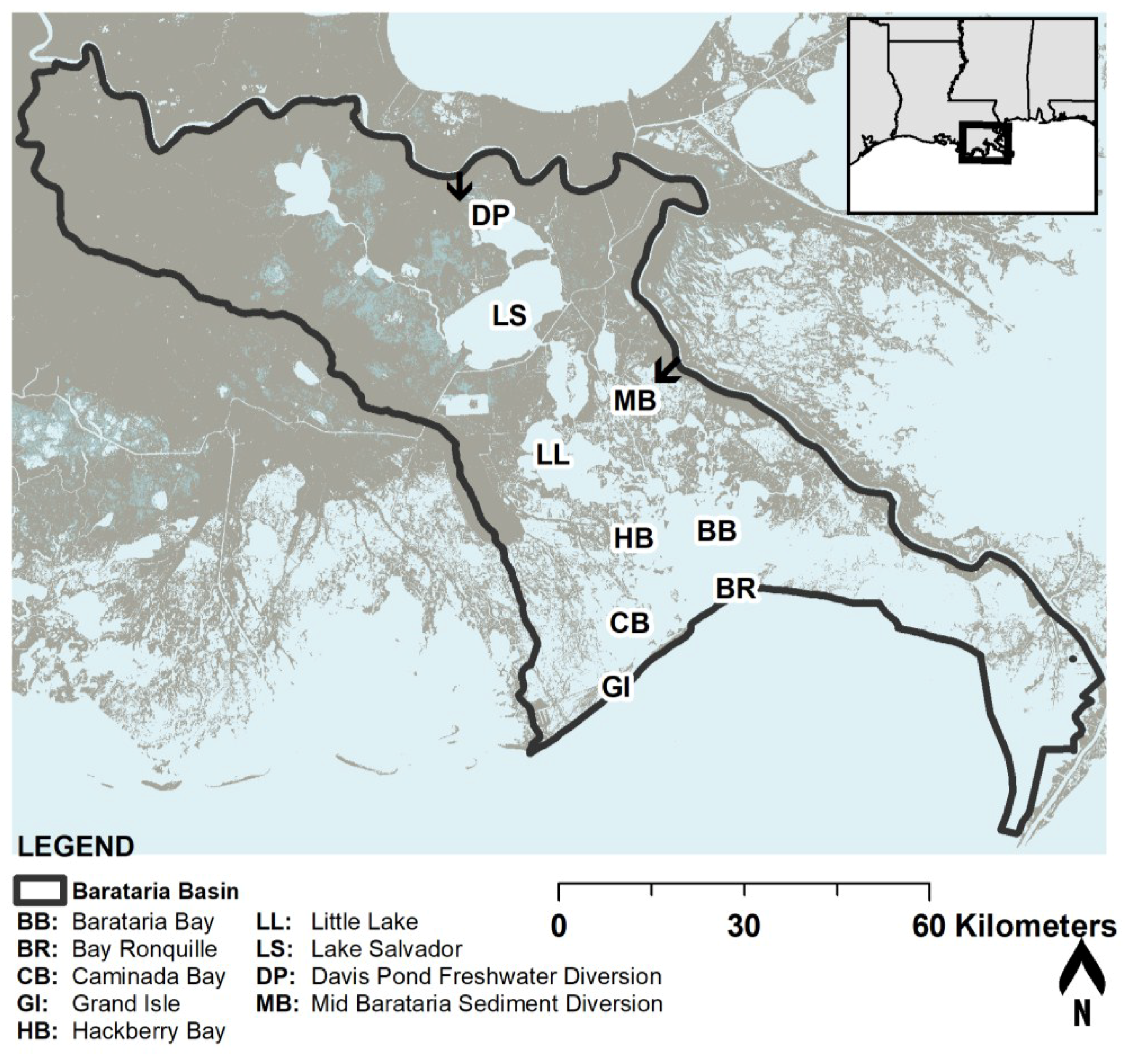

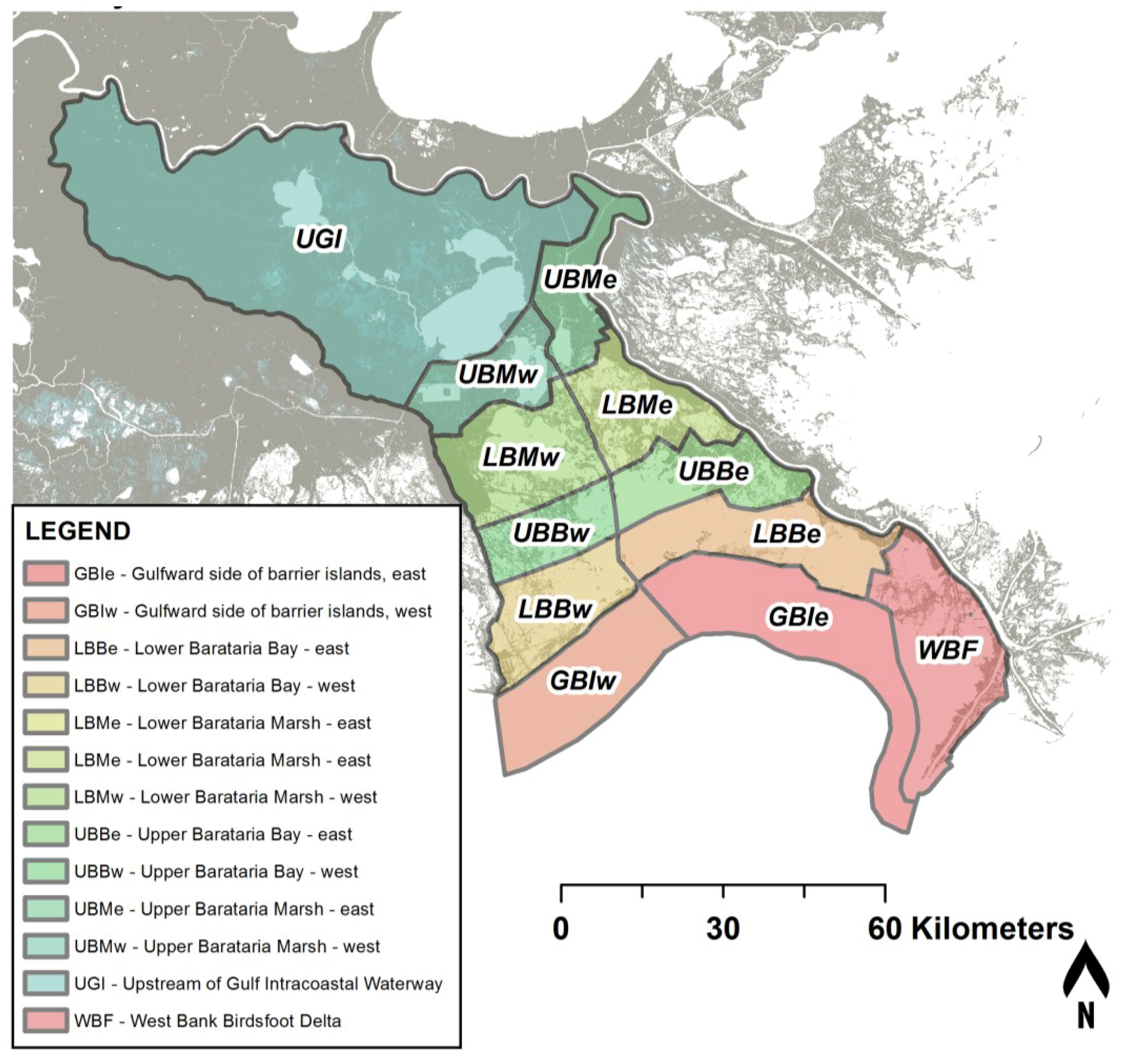
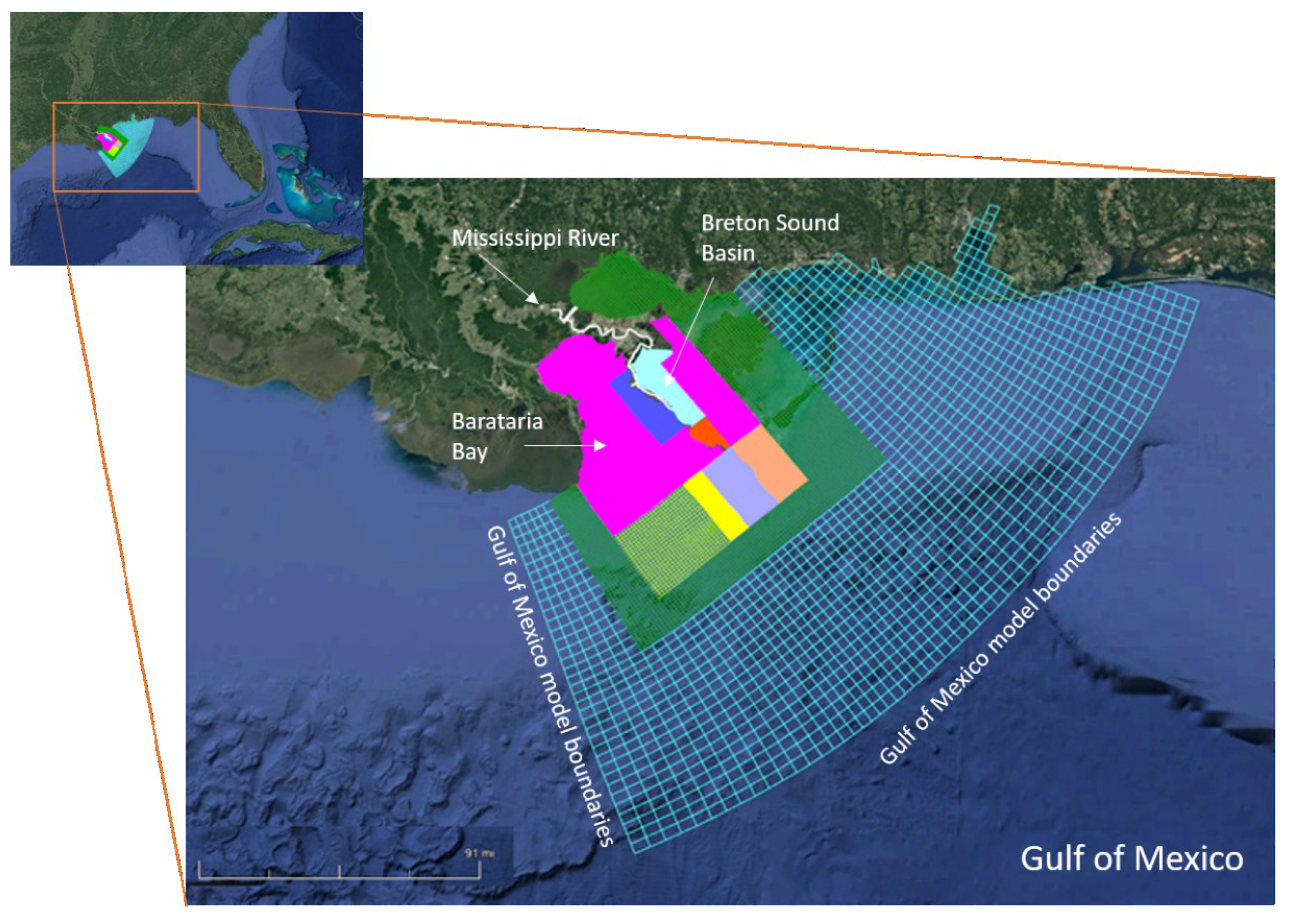
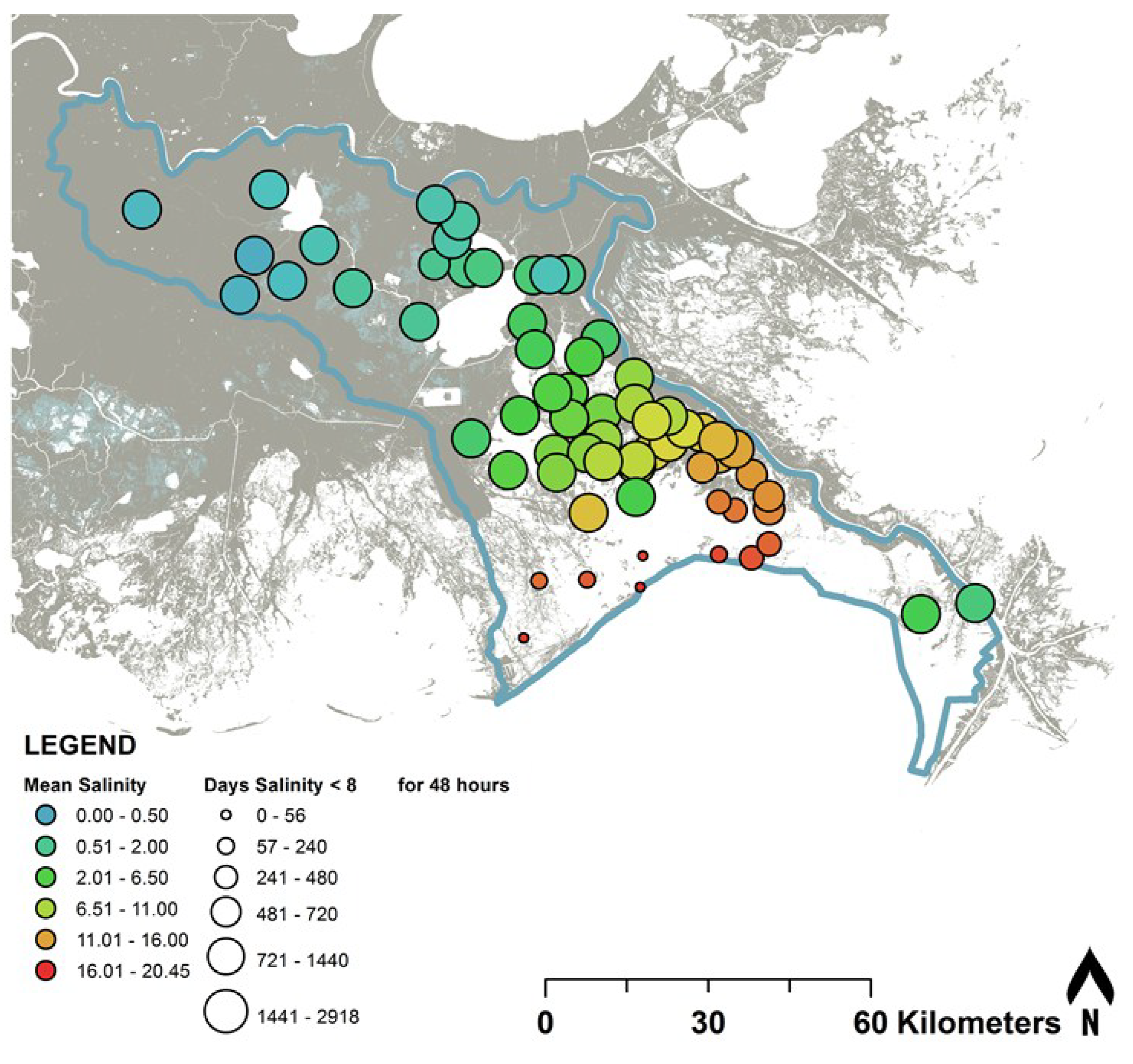
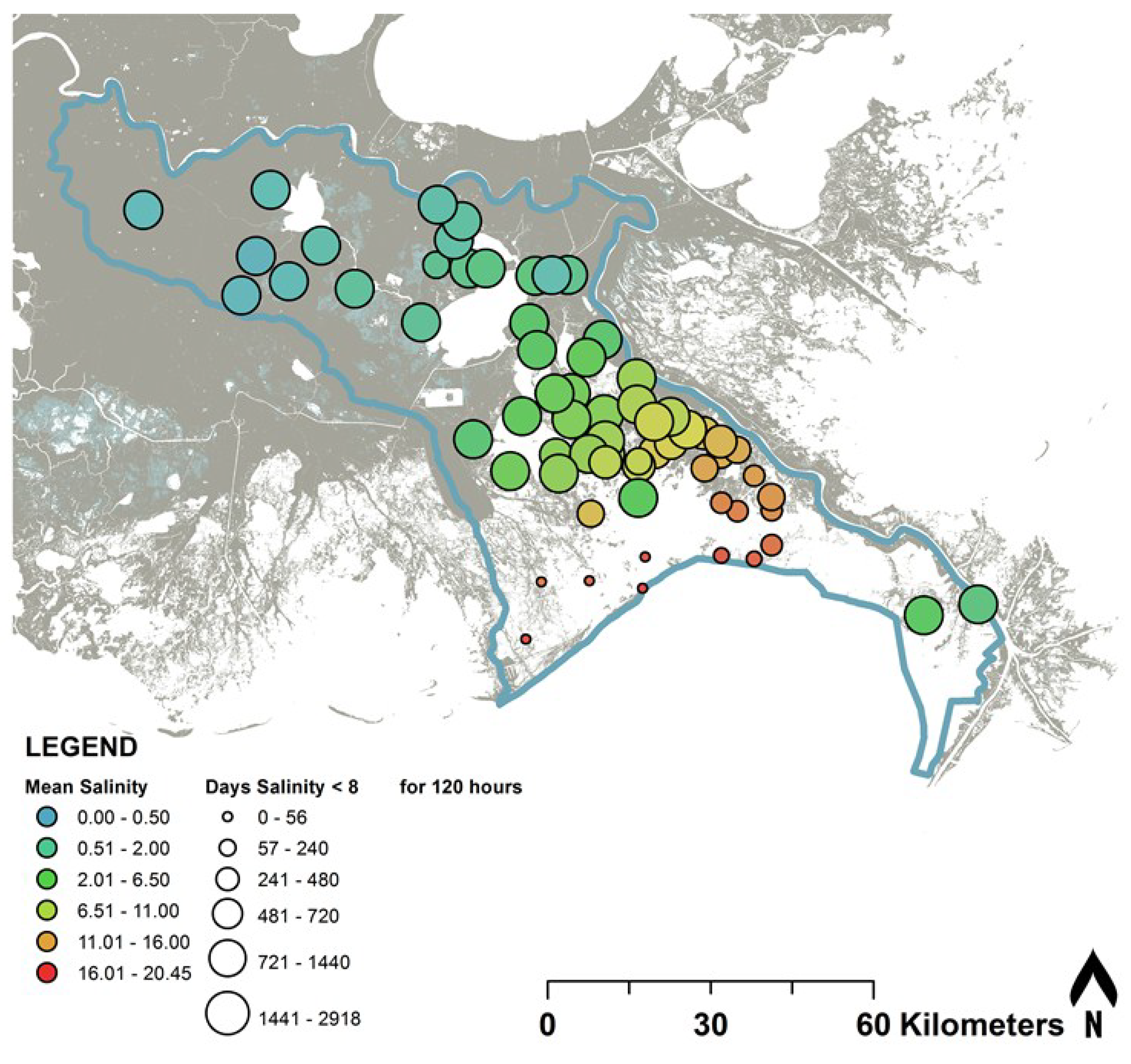
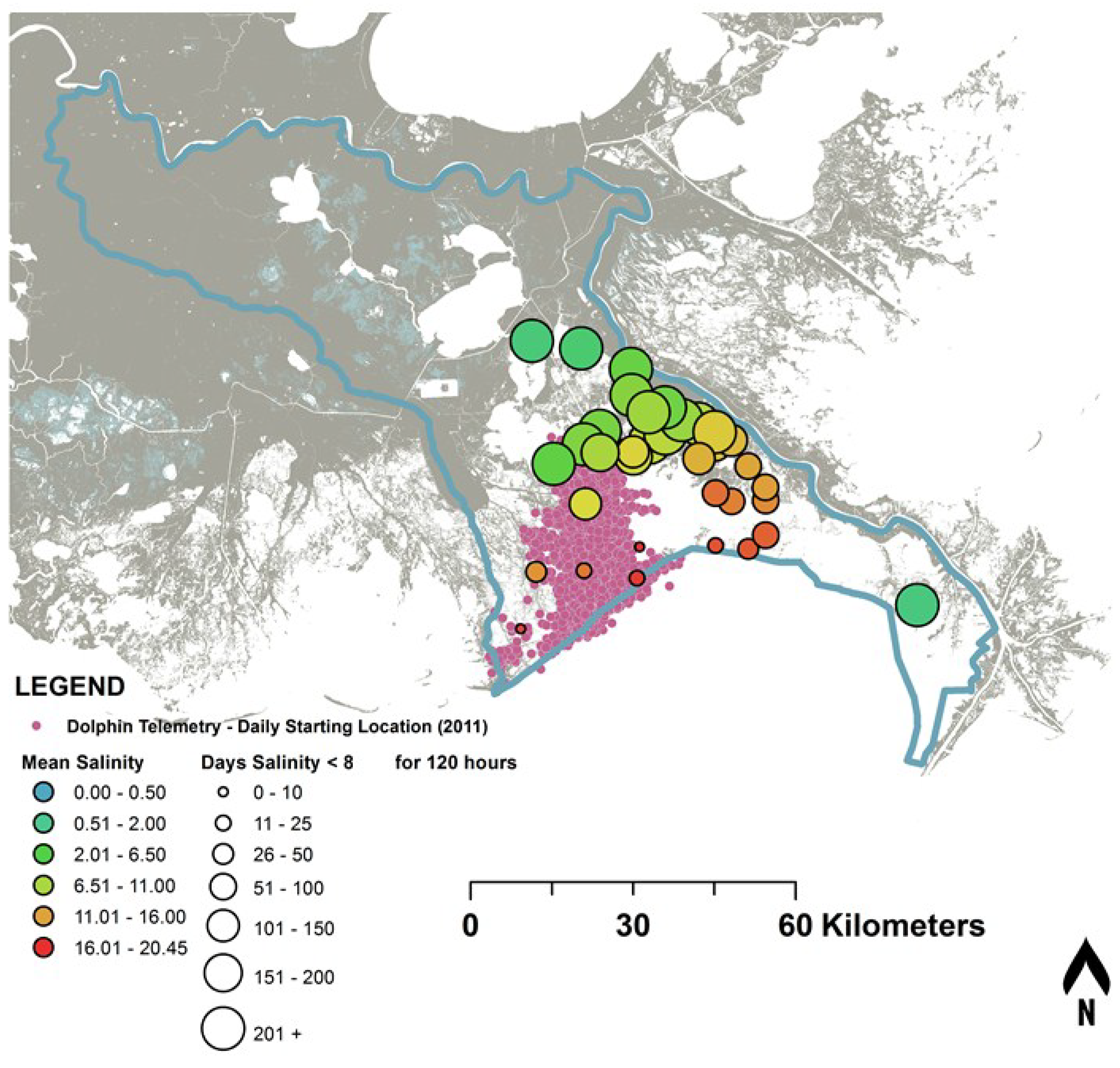
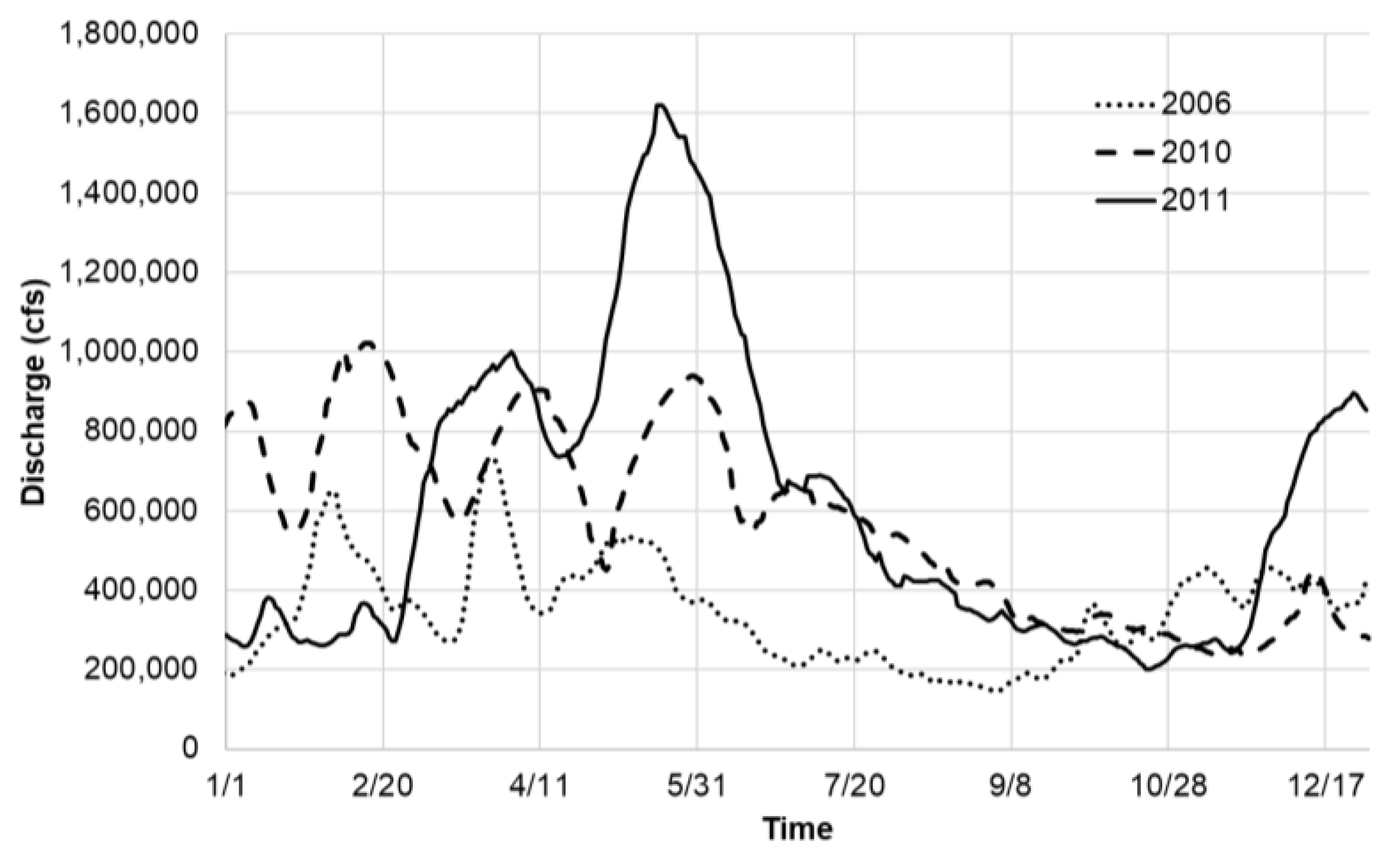
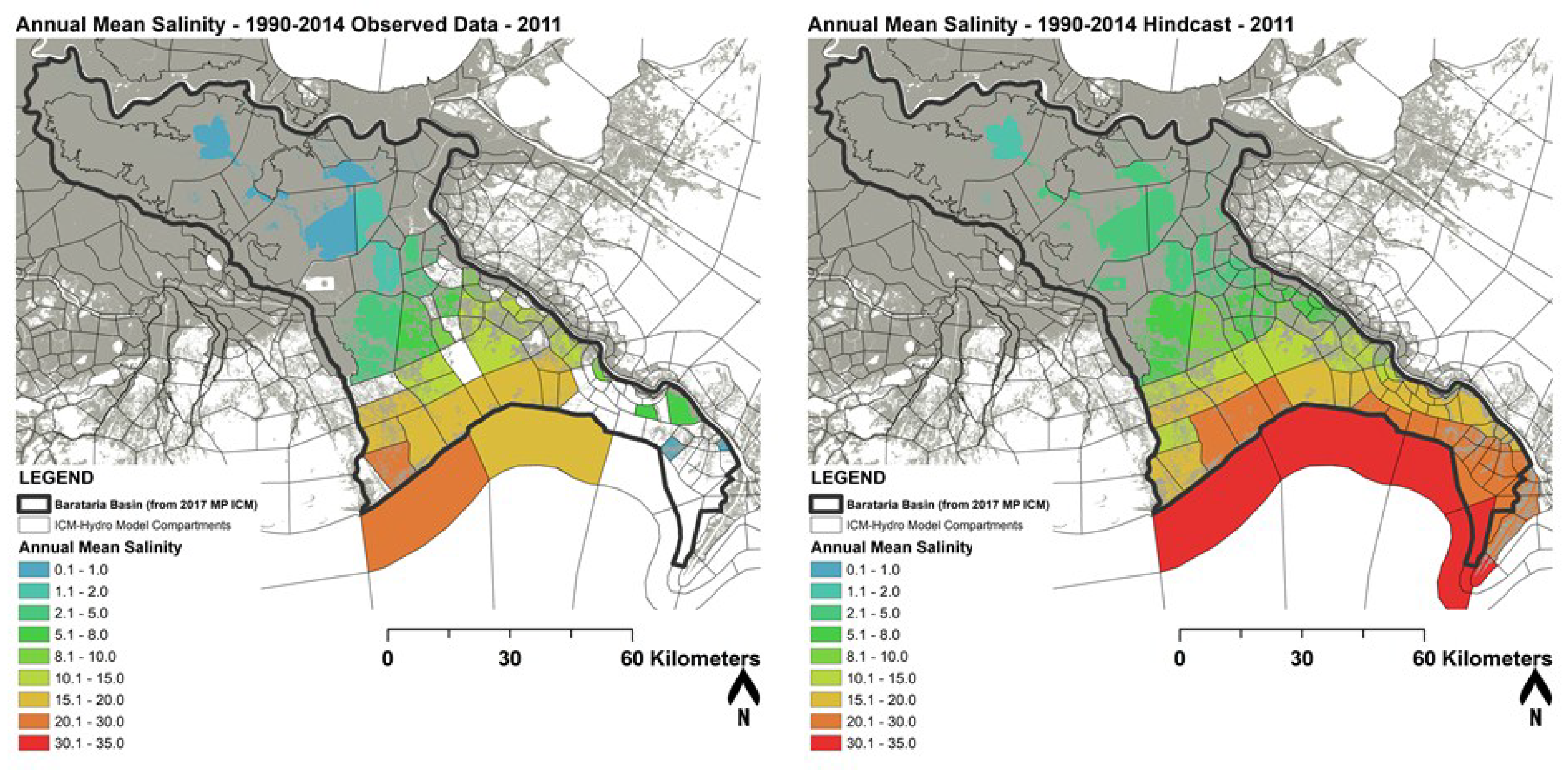
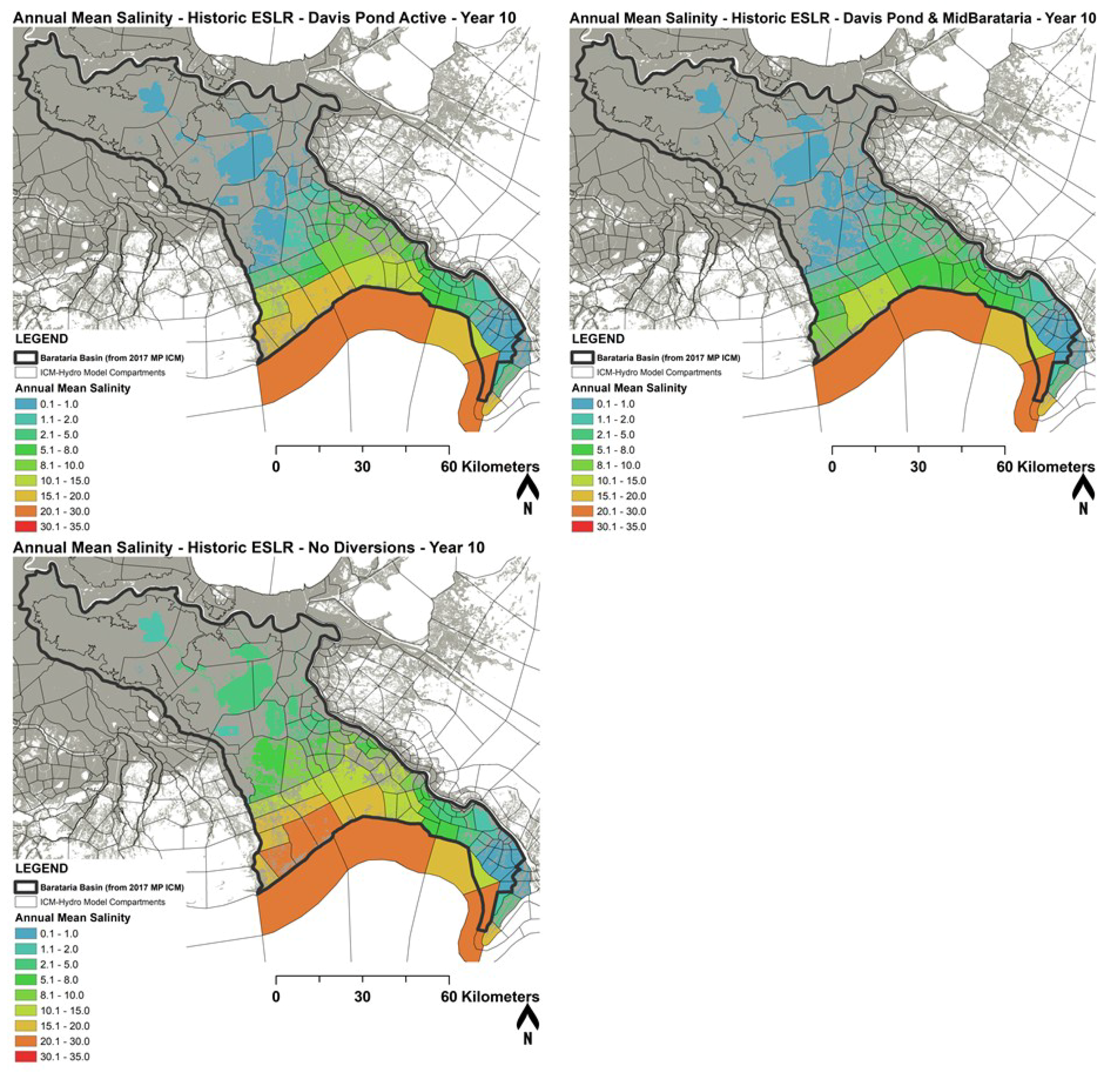
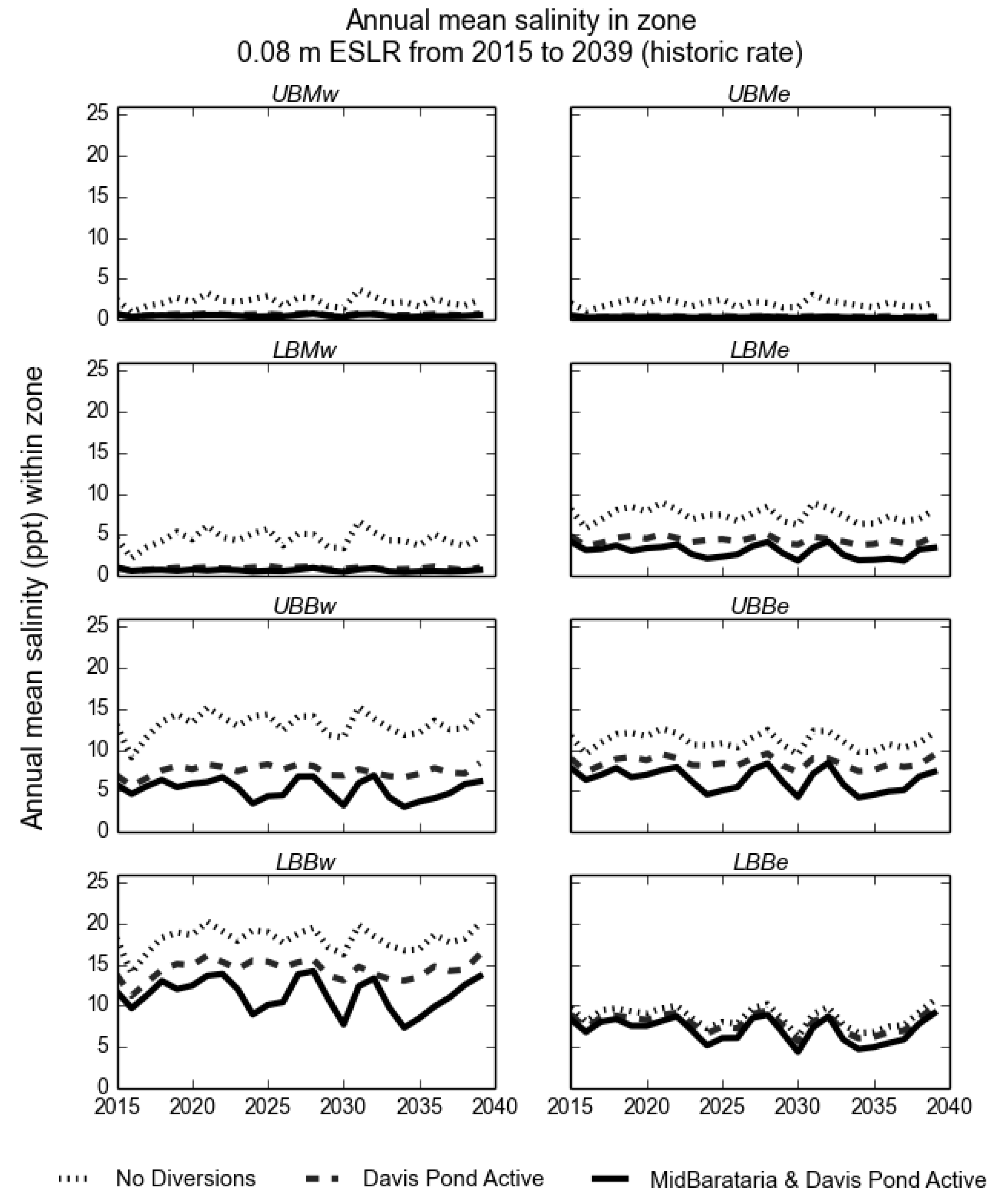
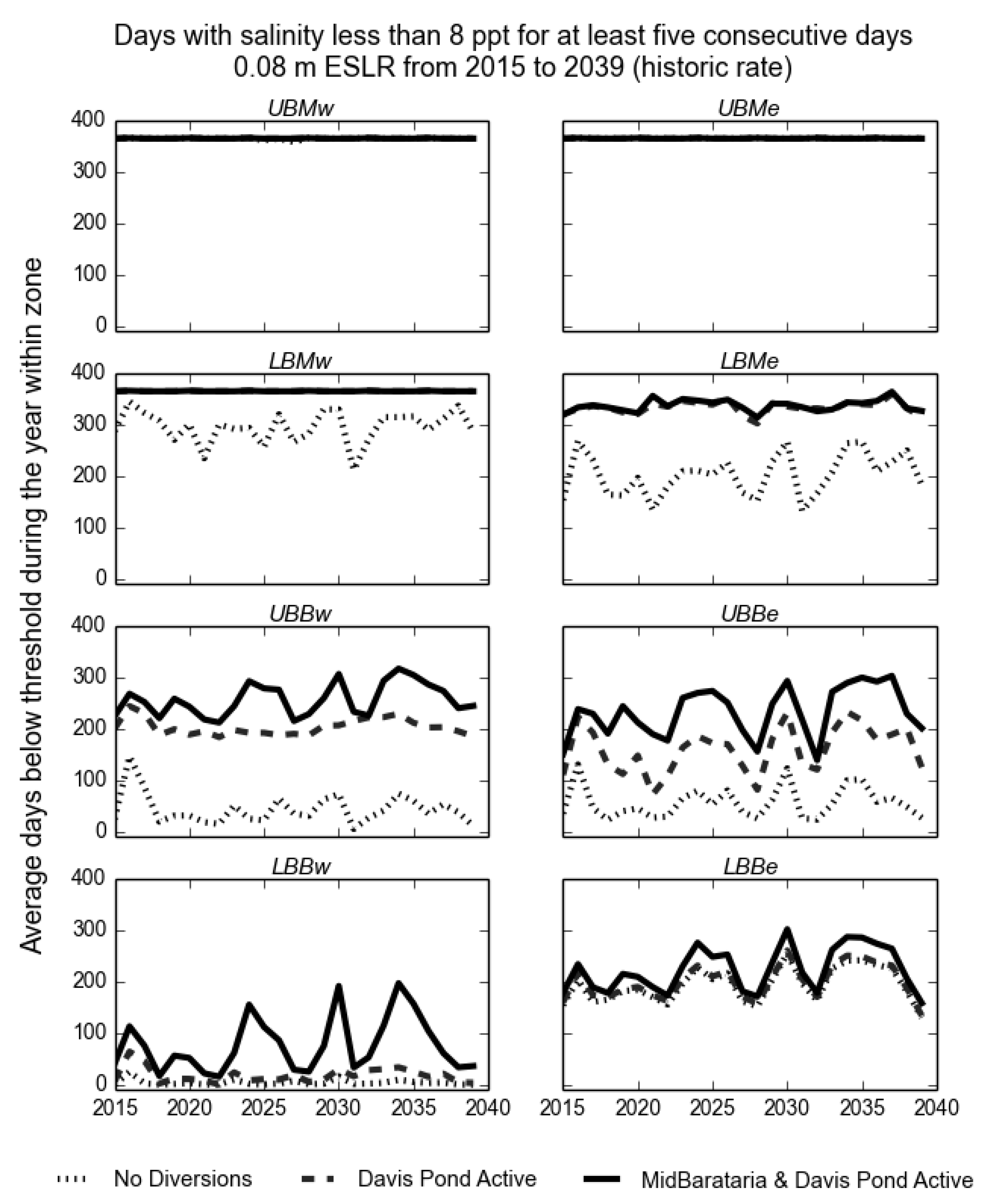
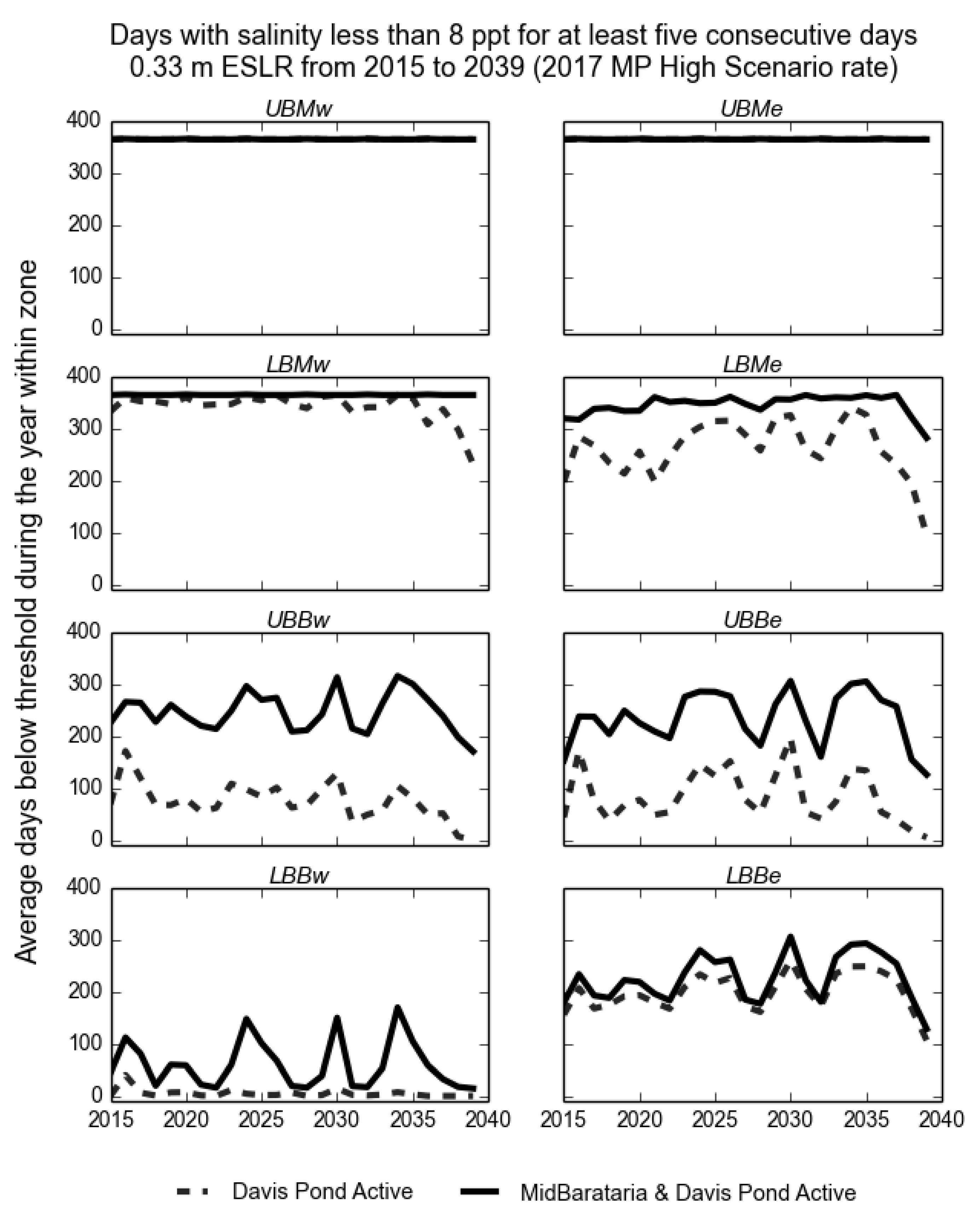
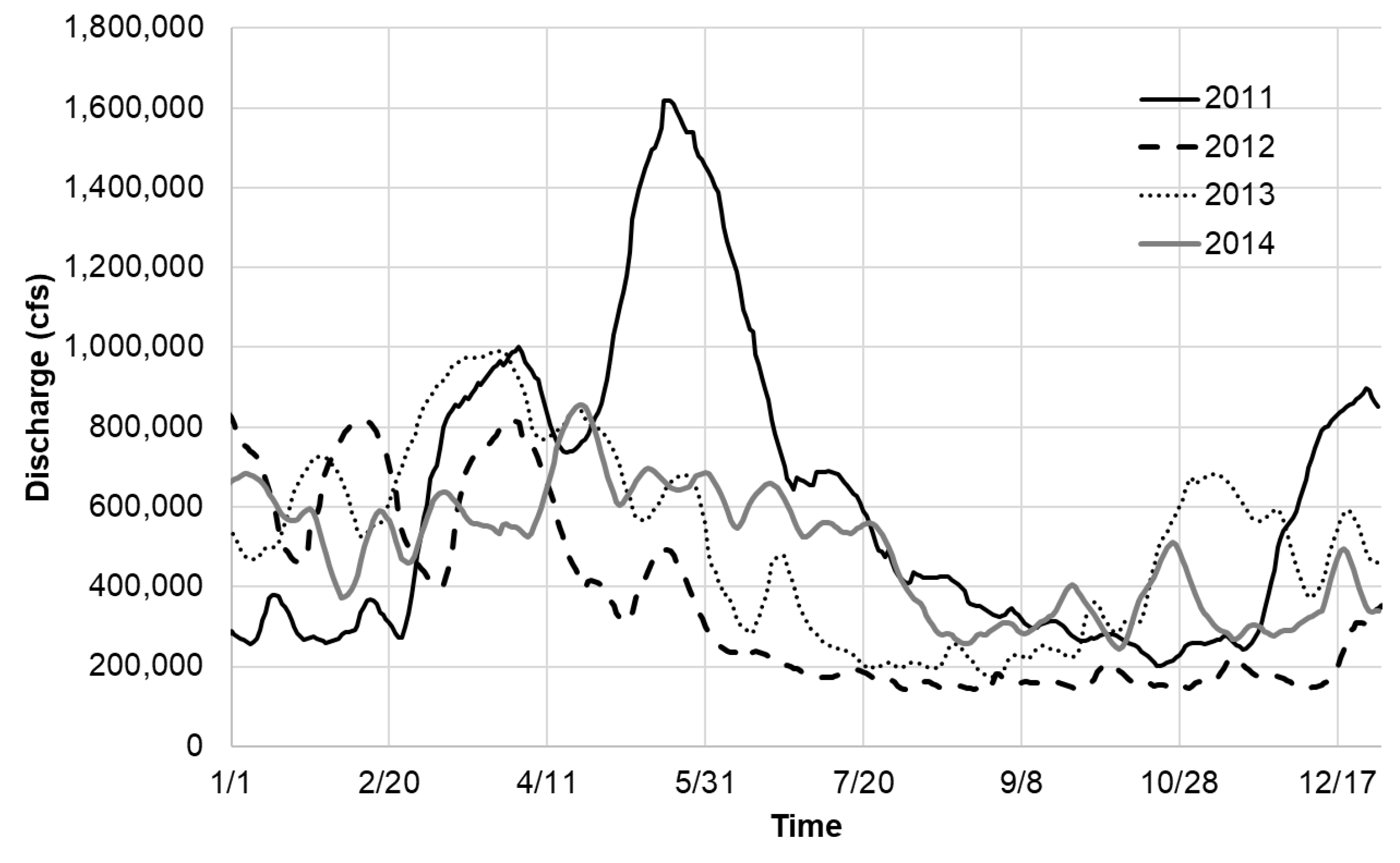
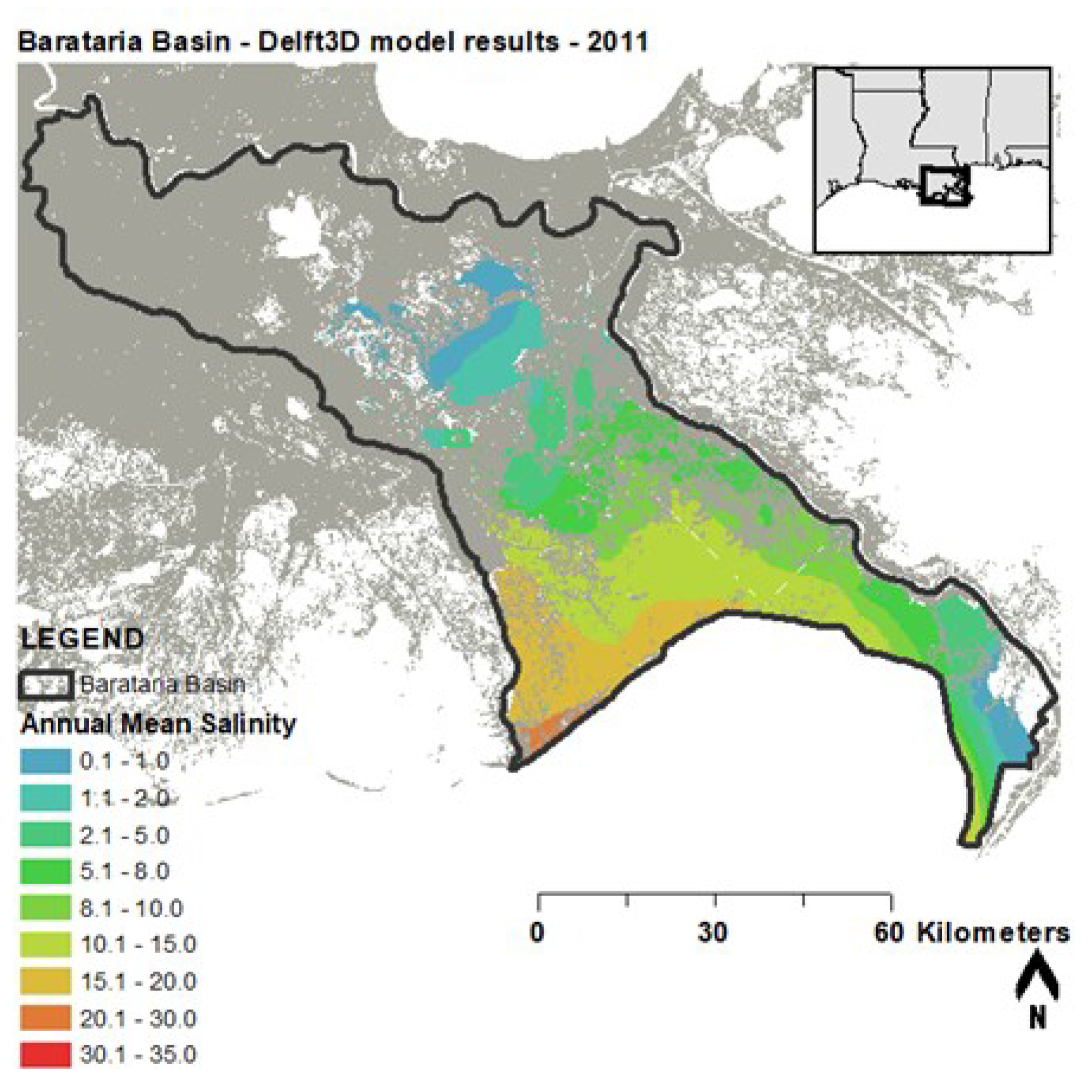
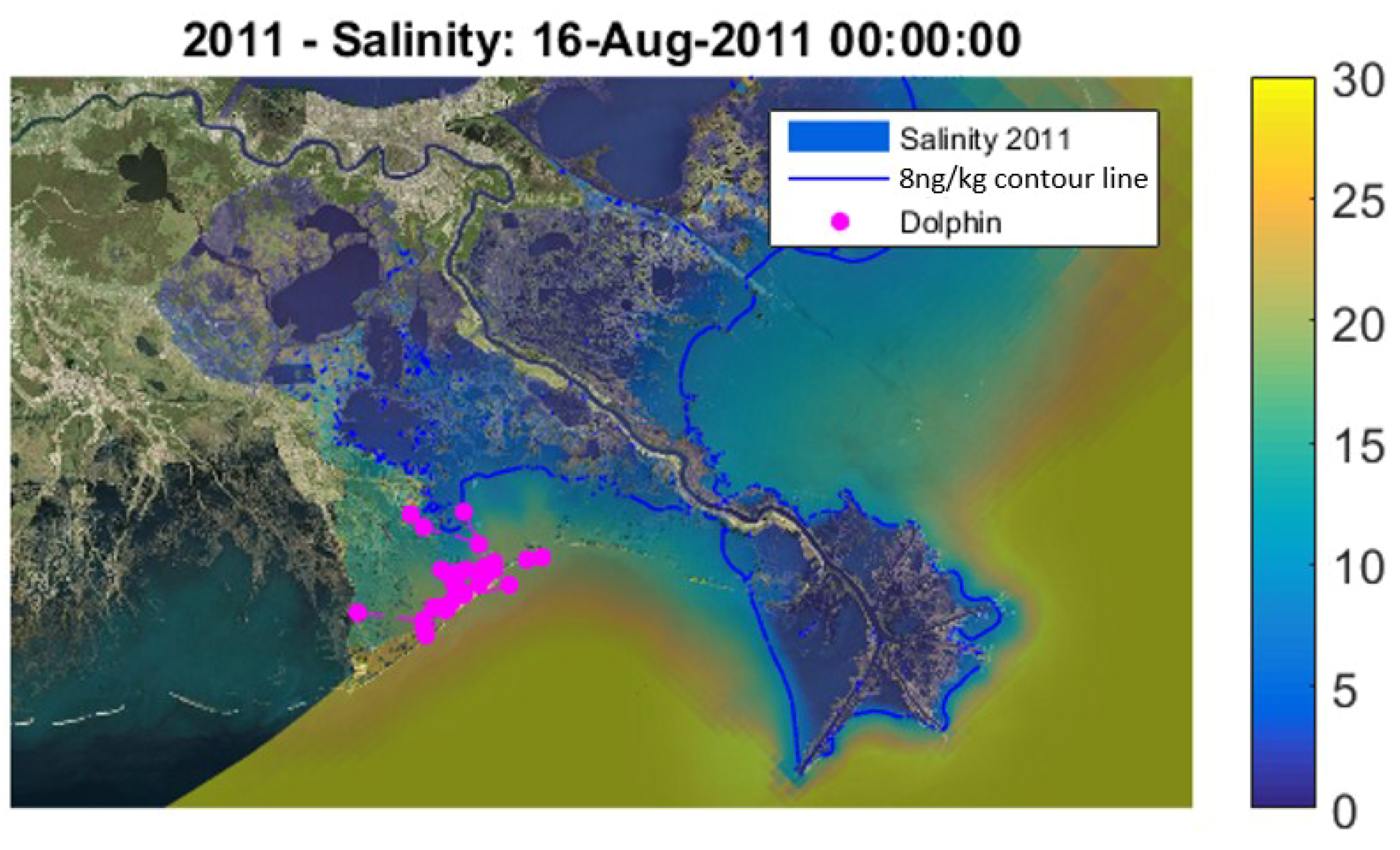
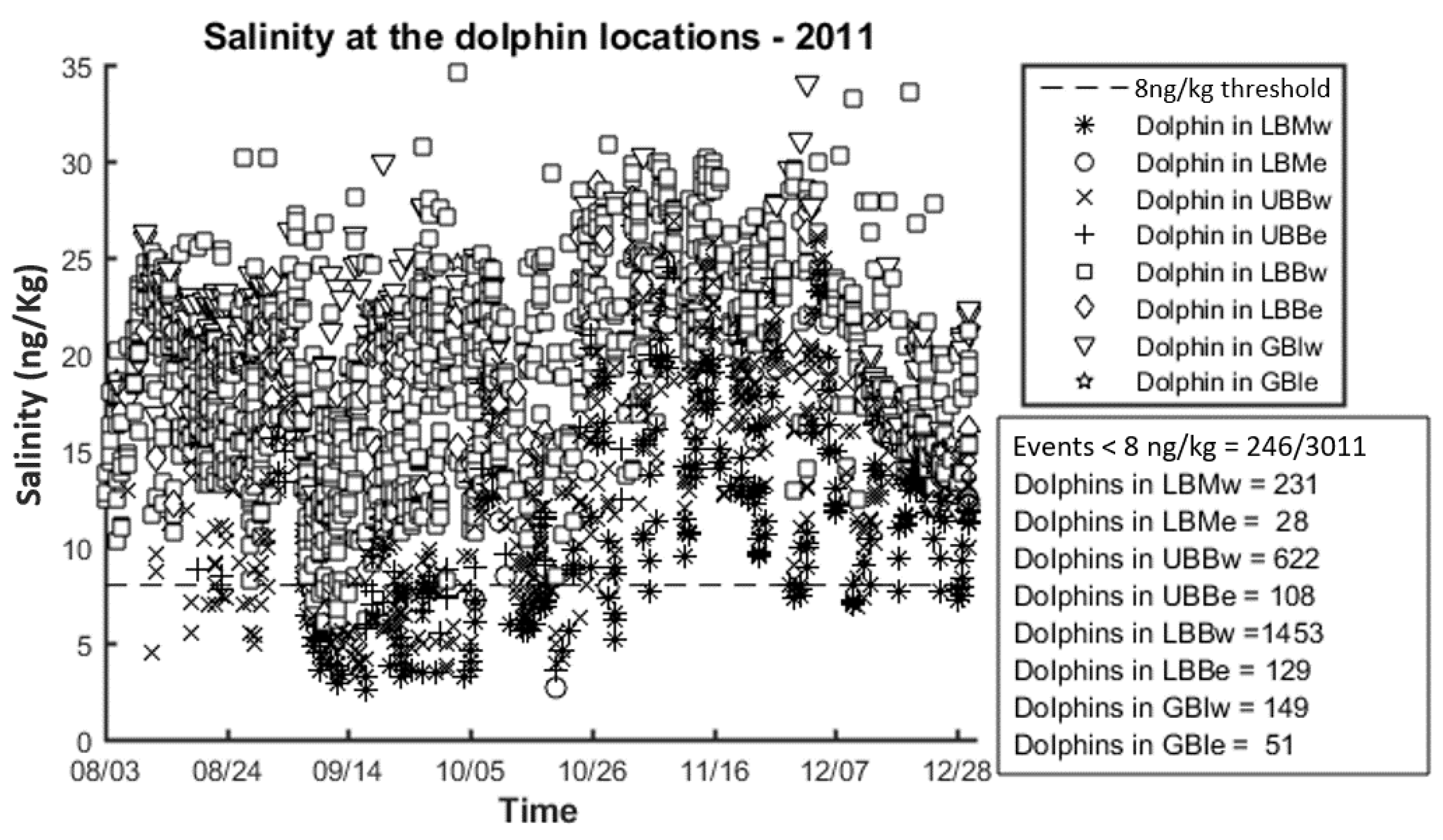
| Zone | Description | Zone | Description |
|---|---|---|---|
| UGI | Upper Barataria Basin upstream of the GIWW | WBF | West Bay and adjacent areas on the west bank side of the Birdsfoot Delta |
| UBMw | Upper marshes between Barataria Bay and GIWW, west of Barataria Waterway | UBMe | Upper marshes between Barataria Bay and GIWW, east of Barataria Waterway |
| LBMw | Lower marshes between Barataria Bay and GIWW, west of Barataria Waterway | LBMe | Lower marshes between Barataria Bay and GIWW, east of Barataria Waterway |
| UBBw | Upper portion of Barataria Bay and adjacent wetlands, west of Barataria Waterway | UBBe | Upper portion of Barataria Bay and adjacent wetlands, east of Barataria Waterway |
| LBBe | Lowermost portion of Barataria Bay and adjacent wetlands, west of Barataria Waterway | LBBe | Lowermost portion of Barataria Bay and adjacent wetlands, east of Barataria Waterway |
| GBIw | Gulfward side of barrier islands, west of Barataria Waterway | GBIe | Gulfward side of barrier islands, east of Barataria Waterway |
© 2018 by the authors. Licensee MDPI, Basel, Switzerland. This article is an open access article distributed under the terms and conditions of the Creative Commons Attribution (CC BY) license (http://creativecommons.org/licenses/by/4.0/).
Share and Cite
White, E.D.; Messina, F.; Moss, L.; Meselhe, E. Salinity and Marine Mammal Dynamics in Barataria Basin: Historic Patterns and Modeled Diversion Scenarios. Water 2018, 10, 1015. https://doi.org/10.3390/w10081015
White ED, Messina F, Moss L, Meselhe E. Salinity and Marine Mammal Dynamics in Barataria Basin: Historic Patterns and Modeled Diversion Scenarios. Water. 2018; 10(8):1015. https://doi.org/10.3390/w10081015
Chicago/Turabian StyleWhite, Eric D., Francesca Messina, Leland Moss, and Ehab Meselhe. 2018. "Salinity and Marine Mammal Dynamics in Barataria Basin: Historic Patterns and Modeled Diversion Scenarios" Water 10, no. 8: 1015. https://doi.org/10.3390/w10081015
APA StyleWhite, E. D., Messina, F., Moss, L., & Meselhe, E. (2018). Salinity and Marine Mammal Dynamics in Barataria Basin: Historic Patterns and Modeled Diversion Scenarios. Water, 10(8), 1015. https://doi.org/10.3390/w10081015





